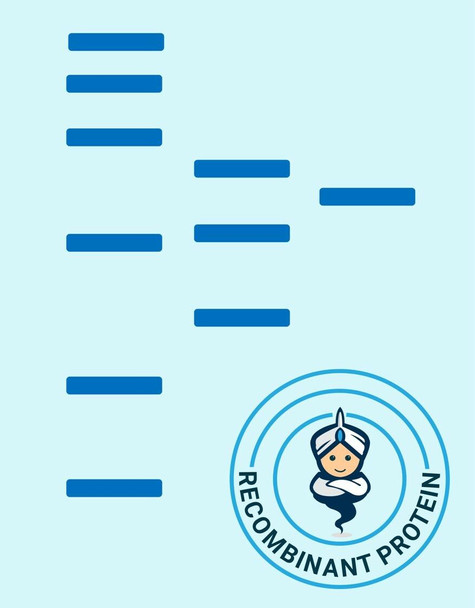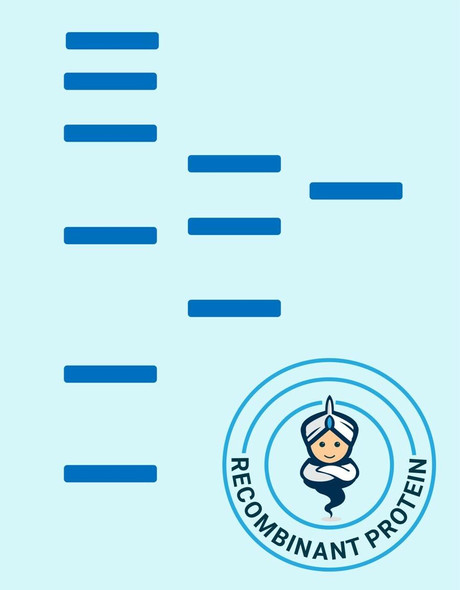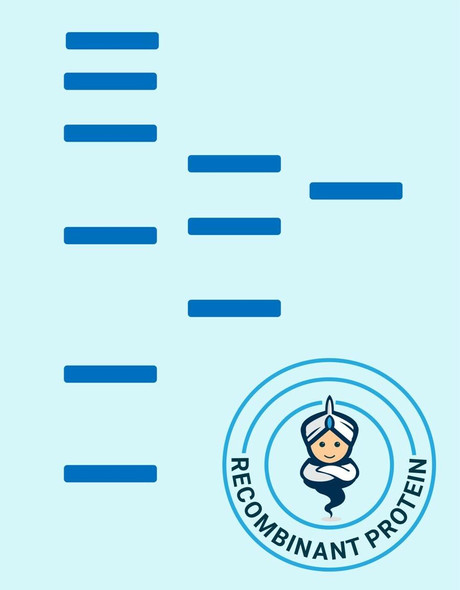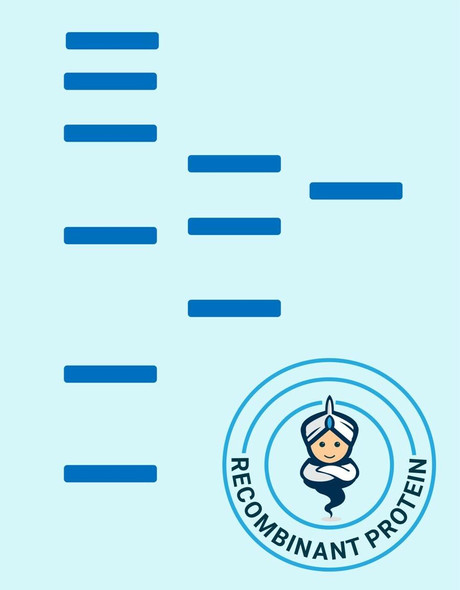Description
| Product Name: | Human Omentin 298 a.a. Recombinant Protein |
| Product Code: | RPPB0815 |
| Size: | 20µg |
| Species: | Human |
| Target: | Omentin 298 a.a. |
| Synonyms: | Intelectin-1, HL1, LFR, HL-1, INTL, ITLN, hIntL. |
| Source: | Escherichia Coli |
| Physical Appearance: | Sterile Filtered colorless solution. |
| Formulation: | Omentin protein (1mg/ml) is supplied in 20mM Tris-HCL, pH-8, 0.4M Urea and 10% Glycerol. |
| Stability: | Store at 4°C if entire vial will be used within 2-4 weeks. Store, frozen at -20°C for longer periods of time. For long term storage it is recommended to add a carrier protein (0.1% HSA or BSA).Avoid multiple freeze-thaw cycles. |
| Purity: | Greater than 90.0% as determined by SDS-PAGE. |
| Amino Acid Sequence: | MWSTDEANTY FKEWTCSSSP SLPRSCKEIK DECPSAFDGL YFLRTENGVI YQTFCDMTSG GGGWTLVASV HENDMRGKCT VGDRWSSQQG SKAVYPEGDG NWANYNTFGS AEAATSDDYK NPGYYDIQAK DLGIWHVPNK SPMQHWRNSS LLRYRTDTGF LQTLGHNLFG IYQKYPVKYG EGKCWTDNGP VIPVVYDFGD AQKTASYYSP YGQREFTAGF VQFRVFNNER AANALCAGMR VTGCNTEHHC IGGGGYFPEA SPQQCGDFSG FDWSGYGTHV GYSSSREITE AAVLLFYR |
Omentin is a recently recognized gene highly localized to the mental tissue (visceral adipose tissue). Omentin is present in the stromal vascular cells in the adipose tissue rather than in the adipocytes. Omentin is predominantly expressed in the visceral adipose tissue than the subcutaneous tissue, with the omentin mRNA being 150 times higher in the visceral adipose tissue. Omentin has also been detected in human blood using western blot analysis, and seems to increase insulin-stimulated glucose uptake in 3T3-L1 adipocytes in mice. Omentin seems to increase Akt phosphorylation irrespective of insulin presence. Its role in glucose metabolism and obesity remains to be described; an insulin-sensitizing action is possible.Differences in Omentin expression has been noted in adipose tissue from normals and patients with inflammatory bowel disease although its significance is unknown.
Omentin Human Recombinant produced in E.coli is a single, non-glycosylated polypeptide chain containing 298 amino acids (17-313) and having a molecular mass of 33.2 kDa.The Omentin is purified by proprietary chromatographic techniques.
| UniProt Protein Function: | ITLN1: Has no effect on basal glucose uptake but enhances insulin-stimulated glucose uptake in adipocytes. Increases AKT phosphorylation in the absence and presence of insulin. May play a role in the defense system against microorganisms. May specifically recognize carbohydrate chains of pathogens and bacterial components containing galactofuranosyl residues, in a calcium-dependent manner. May be involved in iron metabolism. |
| UniProt Protein Details: | Protein type:Membrane protein, GPI anchor Chromosomal Location of Human Ortholog: 1q21.3 Cellular Component: brush border membrane; receptor complex; lipid raft Molecular Function:carbohydrate binding Biological Process: positive regulation of glucose import; response to nematode; positive regulation of protein amino acid phosphorylation |
| UniProt Code: | Q8WWA0 |
| NCBI GenInfo Identifier: | 55976553 |
| NCBI Gene ID: | 55600 |
| NCBI Accession: | Q8WWA0.1 |
| UniProt Secondary Accession: | Q8WWA0,Q5IWS4, Q5VYI4, Q6YDJ3, Q9NP67, |
| UniProt Related Accession: | Q8WWA0 |
| Molecular Weight: | 313 |
| NCBI Full Name: | Intelectin-1 |
| NCBI Synonym Full Names: | intelectin 1 (galactofuranose binding) |
| NCBI Official Symbol: | ITLN1�� |
| NCBI Official Synonym Symbols: | HL1; LFR; HL-1; INTL; ITLN; hIntL; omentin�� |
| NCBI Protein Information: | intelectin-1; ITLN-1; endothelial lectin HL-1; galactofuranose-binding lectin; intestinal lactoferrin receptor |
| UniProt Protein Name: | Intelectin-1 |
| UniProt Synonym Protein Names: | Endothelial lectin HL-1; Galactofuranose-binding lectin; Intestinal lactoferrin receptor; Omentin |
| Protein Family: | Intelectin |
| UniProt Gene Name: | ITLN1�� |
| UniProt Entry Name: | ITLN1_HUMAN |










